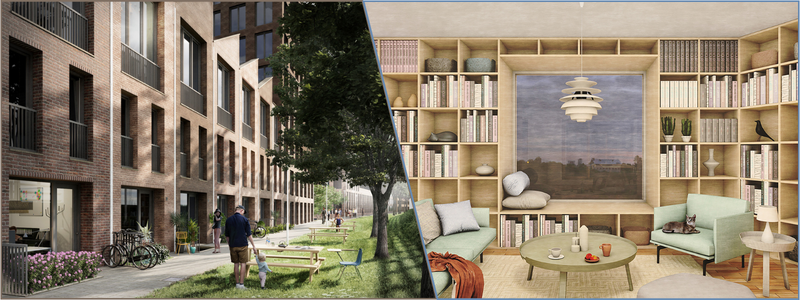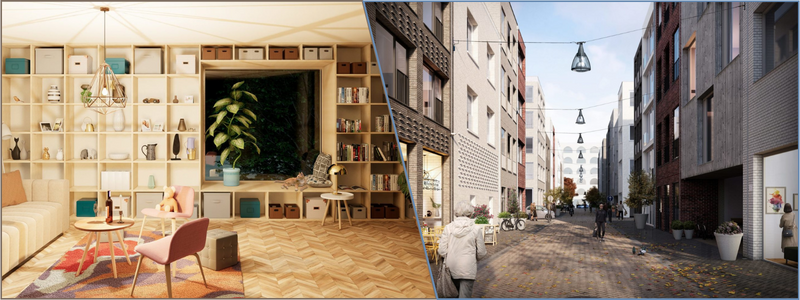Architectural visualization
Today we are discussing 3D architectural animation services and how they can benefit your company. 3D animations are found everywhere and used by product designers, furniture companies, sellers on eBay, and architects. The production process of a 3D architectural animation is similar to an animated film. However, architects mostly need visualization of their design concepts rather than interactions between actors. The same applies to architects, who excel at planning construction projects but don’t always know how to develop an animated design presentation.
RELATED: 5 Uses of 3D architectural animation for marketing your new development project
Not everyone can produce good-quality animations, so they use outsourcing services to create 3D animations. There are many ways to visualize an architectural project. A rudimentary sketch and blueprints are great options among architects and designers, but these images are technical and too complicated for an average person to interpret. A static 3D rendering is a client-friendly medium, depicting a building, a house, or a room like a photograph. Even if the object does not exist, a render artist can develop a lifelike image of the project based on CAD and BIM files provided by architects.
A 3D CAD rendering artist working for an architectural animation service uses the information included in a CAD file vividly represent the plan. Every 3D model is designed on the computer, and the complexity and scope increase as more objects are added. All models are put together into a scene for one static render; the result is a photorealistic architectural visualization. In short, the render artist transforms all those ideas and details into an easily understandable image that clients can see and explore. Clients provide feedback on the design, and then the 3D architects refine it accordingly.
RELATED: Differences between interior design and interior architecture companies
3D architectural animation workflow
Every 3D architectural animation service has a specific approach to a project, but the process is generally the same across the board. The first step in hiring a firm is the consultation phase. The client and animator engage in a brainstorming session to explore a few possible designs. To help the 3D animator produce accurate design concepts, the client must explain the following:
- Project goals
- Preferred design styles
- Intended use of the animation
- Target audience
- Brand guidelines for a commercial project
RELATED: How 3D animation services help architects showcase new properties & buildings
The client provides relevant information about the design objectives, while the 3D modeler analyzes the brief and comes up with a feasible idea. At this point, any concept is rough and probably drawn as pencil sketches. It is still an early phase in the workflow, so the primary purpose is to align on the 3D animation project. Once a specific design is approved, the collaboration decides what objects to include in the 3D architectural animation and its aesthetic vibe.
Following the phase is the 3D modeling task, where all objects in the animation start as 3D models. Accuracy in color, material, texture, and dimension is of the utmost importance for a realistic render. The modeling and rendering processes depend heavily on the nature of the project. The 3D animator may draw everything from scratch or purchase ready-made models from online 3D assets marketplaces for a full-range 3D model animation service. Although purchased models might require modifications, it can be quicker than creating everything from scratch, given a tight timeline. In some cases, the clients already have the necessary 3D models.
RELATED: How your company can save money with 3D models
Before rendering starts, the CAD files are sent to the client for approval. It is common for a client to ask for some model revisions. An architectural animation may include environmental objects and construction-related items, especially for the exterior view. The scenery is often as important as the main building to highlight the structure’s best view from a specific angle.
A skyline filled with sunlight, wind, water, vegetation, and even animals improves photorealism. Due to the potential complexity, the 3D modeling phase accounts for most of the timeframe, and when given the green light, the 3D architectural animator begins the rendering process. In a comprehensive workflow, the rendering phase occurs a few times before the final image is ready.
RELATED: How 3D rendering has revolutionized interior design

1. Grayscale render
A grayscale or clay render has all the main objects in the rendering but lacks colors and textures, as geometry and proportion are the primary focus. For interior design visualization, the 3D interior rendering expert must also consider furniture position and camera angle. The client can ask for revisions on the object selections and perspectives, but changes that require another 3D modeling process come at an additional fee.
2. Colored proof
A 3D rendering comes to life during the “colored proof” phase after the 3D animator puts textures, lights, and materials into the image. Thanks to the additional data, all digital objects in the frame will appear identical to their physical counterparts. It is not yet a photorealistic image but comes close to being lifelike. Only minor revisions, such as color correction and removal of decorative objects, are allowed.
RELATED: Top reasons for using rendering in the 3D animation process
3. Rendered image
With lights come shadows, and as the colored-proof image enters the next rendering phase, the lighting aspect becomes the priority. The process analyzes the natural behaviors of light and how it affects the surrounding environment. Objects of different materials, colors, and textures also reflect and refract light uniquely. The positions of artificial and natural light sources will determine the direction and intensity of shadows. Final touches involve superficial refinements to color balance, contrast, brightness, and saturation in photo editing software.
3D architectural animation overview
Since an animation requires many static renders per second, the phases mentioned above are repeated until there are sufficient images to build a fluid sequence. The 3D architectural visualization company must create a 24fps animation that is smooth enough. However, some architectural animation services offer up to 60fps format for fluid motion.
RELATED: Why you should hire a 3D walkthrough animation service for your architectural project
Expected timeframe
Various factors affect the expected timeframe and cost. Apart from complexity and the desired level of detail, the resolution and frame rate also play significant roles. An animation takes much longer to render than static images, and a 24fps animation contains 24 images played in sequence per second. If one Full HD static render of a building takes 3 hours to complete, a 24fps animation of that resolution should require a 72-hours. The next thing to consider is video duration; a minute of architectural animation needs 1,440 images and 480 hours to be ready.
Assuming your project is a priority to the 3D animator, it is a reasonable timeframe. Higher resolution and longer duration take more time. In a smaller-scale project, such as interior design or a small cottage, the expected timeframe shortens. Some services offer an expedited completion deadline for an additional cost. A 3D architectural animator can use a “render farm” to gain access to a multitude of workstations equipped with redundant hardware resources to speed up the process. The associated cost to access the render farm is billed to the client.
RELATED: Architectural VR/AR 3D rendering costs, rates & 3D modeling pricing for design firms
3D animation – cost, price, fees
There is no standard pricing for architectural animation services, and the final cost always depends on the difficulty level of the project. Even if two clients want to render the same building with identical specifications, one can potentially pay more than the other for many reasons. For example, one of the clients provides a comprehensive project brief and many 3D models for the animator. In contrast, the other gives only a basic description of the building, which means a more extensive project for the 3D visualizer artist. Providing precise project requirements may reduce the cost of the animations.

The price starts at the bottom of the range from $100 per second of 3D animation. For that amount, quality is subpar, and the timeframe can be longer than ideal. Alternatively, you can expect to pay $1,000 per second for state-of-the-art quality. Going for either the most affordable or expensive is never a good idea. Instead, you should focus the search on midrange prices.
RELATED: What Are Architectural Animation Costs, Rates, & 3D Design Pricing for Companies?
The firm you hire will also play a bit into the pricing. An experienced firm with a wide range of portfolios may ask for double the amount of an individual freelancer. Cost is an important question, but it is not recommended to pick any particular service based solely on the price factor. Please review the freelance 3D architect’s portfolio and ensure the 3D animator is conscious of the budget.
Protecting your project details
Hiring an external architectural animation service comes with the risk of losing valuable information and sensitive details about the project. If you have security concerns, have the animation firm sign an NDA, not just the actual 3D animator tasked with developing the animation. Finding an animator who offers the services you need is easy, but finding one you can trust and who shares your design preference can be challenging. The most critical step is ensuring the animation firm is a legitimate company. If you hire a freelancer overseas, be confident they can be contacted easily through a reliable platform or that you work with a project manager to handle all the communication.
How Cad Crowd can assist
At Cad Crowd, hundreds of highly qualified, pre-vetted architectural design freelancers can help with any project. Find out how it works. Contact us for a free quote today.
